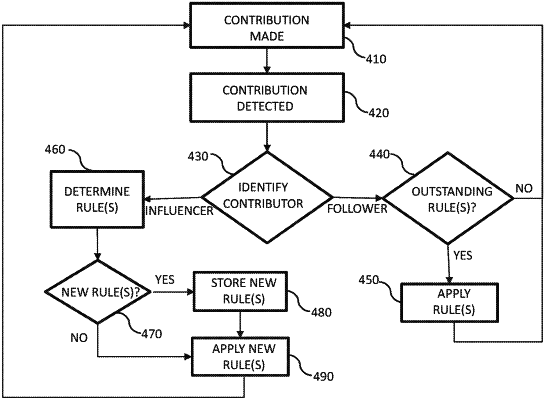| CPC G06Q 10/06313 (2013.01) [G06F 40/211 (2020.01); G06F 40/253 (2020.01); G06N 20/00 (2019.01); G06F 40/232 (2020.01)] | 18 Claims |

|
1. A computer-implemented method, the method comprising:
identifying one or more influencers and one or more corresponding followers, amongst a plurality of contributors of a collaborative development project, wherein a hierarchy is used to identify the one or more influencers and the one or more corresponding followers, and wherein the one or more corresponding followers have only one influencer;
analyzing a contribution of the one or more influencers, wherein the contribution comprises at least one of one or more cognitive characteristics, one or more syntax styles, and one or more language patterns of program code within the collaborative development project wherein analyzing the contribution of the one or more influencers comprises:
processing, with a machine learning algorithm, the contribution of the one or more influencers within the collaborative development project;
learning, dynamically, a set of software development rules to apply within the collaborative development project, based on the contribution of the one or more influencers;
utilizing a universal code formatter known as CodeBuff to determine the set of software development rules to apply within the collaborative development project;
reformulating, dynamically, the set of software development rules based on the contribution of the one or more influencers;
leveraging a large collection of other sample projects to identify development characteristics of the one or more influencers;
storing, in the collaborative development project, the reformulated set of software development rules, based on the contributed program code of the one or more influencers, that are not previously stored as rules;
identifying a second contribution from the one or more corresponding followers within the collaborative development project, wherein the second contribution comprises cognitive characteristics, syntax styles, and language patterns of program code within the collaborative development project;
assessing the second contribution, from the one or more corresponding followers, against the stored set of software development rules;
determining that the identified second contribution from the one or more corresponding followers, within the hierarchy, does not adhere to the stored set of software development rules within the collaborative development project; and
modifying, automatically, the identified second contribution of the one or more corresponding followers with the reformulated set of software development rules, based on the contributed program code of the one or more influencers.
|